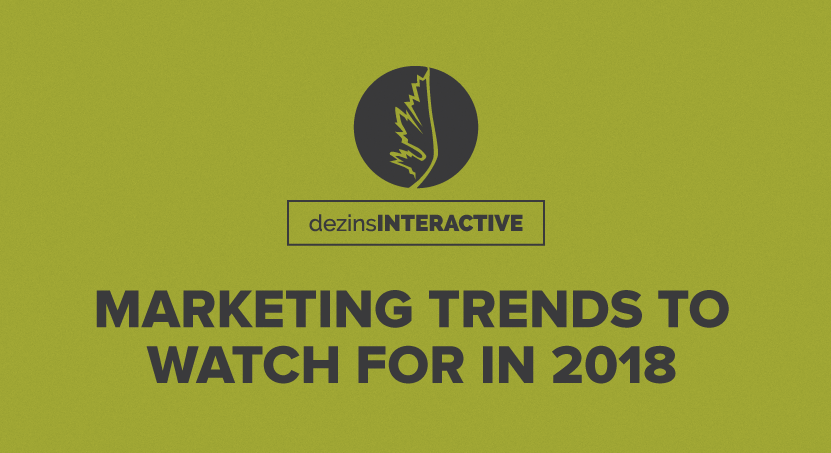As the year comes to end, we begin reviewing the last twelve months and looking forward to what the next twelve will hold. As with every year, 2018 will bring a shift in how marketing is done. With implementations of new technology, updated platforms, and endless Internet space, the field of marketing is getting ready to expand with new horizons. Let’s look into a few trends that we see growing into the new year.

Video Streaming
Video really is the future of content marketing and it’s a format that’s gained serious momentum in the last 12 months. Video streaming was 75% of all internet traffic in 2017, and it shows no signs of slowing down. Social media giants like Facebook, Instagram, and Twitter are investing more energy and money into improving their video capabilities. For starters, Facebook video sees an average of 135% more organic reach than images.
Mobile video ad spend will grow 49% to roughly $18 billion in 2018, reports Recode, while non-mobile video ad spend is expected to fall 1.5% to $15 billion. You can expect to see a decline of video consumption on laptops and computers for the first time — while video views on phones and tablets is expected to grow by 25%.
It’s clear that video has become a major player when it comes to driving engagement. According to the Content Marketing Institute, audiences are around “10 times more likely to engage, embed, share, and comment on video content than blogs or related social posts”. This is because video speaks one, universal language, meaning you’re able to connect with many audiences right across the globe.
With the younger demographic viewing more video on a wider range of devices than ever before, in 2018, video advertising will prove very fruitful for brands or businesses looking to market their products or services.

Virtual Reality
While live video is super engaging and certainly interactive, there’s another kind of interactive visual content that allows you to create an entirely different experience for your audience – virtual reality. VR refers to an artificial, computer-generated environment that uses high-end graphics, as well as audio and aural sensations, to make users feel as if they are in a real world where they can interact with – and sometimes manipulate – what’s around them. Most VR experiences are generated through the use of specialized headsets that fully immerse a person in the virtual world.
This offers new opportunities for content marketing as well as customer engagement. For example, Ikea is now rolling out ‘Place,’ an app for iOS users to preview furniture in their home before buying. This type of VR integration with ecommerce is ingenious as Ikea seeks to increase conversions by showing customers how their products will look in the surroundings of their own home. Mainstream consumer adoption of VR technology will be key to it becoming successful and widely used as a marketing tool. But even before that time comes, brands with a clear and innovative use for VR can blaze a trail, showing consumers the possibilities of VR and helping to lead the way in establishing its place in marketing.

Micro Influencers
With more content on the Internet than ever before, it seems almost impossible to get your message across to people. Social media is swarming with paid advertisements and corporate sponsors, and it’s not getting any less cluttered. People take to the Internet and social media to find recommendations on products they’re looking for, but with all the content on the web, who are they actually listening to?
Micro-influencers are digital influencers with a total audience size of between 1,000 and 100,000 followers. They are public figures, experts, etc. more likely to post about specific niche topics, and they have the loyal followings that share their passion. With more than 32% of internet users enabling ad blocker in 2017, it’s increasingly harder to reach users and micro influencers can bridge that gap moving into 2018. The ever-narrowing organic window offered by social networks for brands and the ever-growing sea of noise that is content creators today means the trusted ones with large, engaged followings will rule the day for media and placement.

Artificial Intelligence (AI)
Combined with big data and machine learning, AI is expected to make a huge impact on how we market to our consumers. Users can expect highly-customized content delivery, automated based on their persona and lifestyle. Starting an AI strategy can be costly and require specific skill that are often hard to come by as the role is in such high demand. However, the large upfront investment shows promising results for those willing to take the plunge.
According to a Salesforce State of the Marketing Report, 57% of marketers using AI already say it’s absolutely or very essential in helping increase touch points with customers and prospects. The ability to respond quickly and accurately to shifts in customer behavior will be vital in tomorrow’s world as people become more demanding, as well as tech savvy. Machine learning will assist in those efforts, offering nuggets of predictive knowledge in the waves of structured and unstructured data that can be leveraged to your advantage.

Story Telling
Stories have become one of the greatest currencies of business. This is because goods and services have become largely commodified by price point and customers are looking for brands they can believe in, be a part of, and make statements through, that echo their personal ethos.
In the year ahead, smart marketers will use a strategic mix of creativity and technology to generate and deliver stories that create lasting connections with customers. This will involve leveraging data-driven insights on both the science AND art side of the marketing function.
Using the power of cognitive tech to unearth storylines that convey authentic voice and emotionally engage, as well as personalize and best time interactions, will empower companies to emerge as much as best-in-class content brands, as leaders of their given industries. Remember that customers today don’t buy into things, they buy into stories brought to life through a strategic mix of creativity and technology.
As our technology continues to advance and platforms begin to grow, we must strive to connect with our consumers and bring them an experience they can both share and connect with. Every brand has a mission statement, and with that mission statement is a story to be brought to life. It is one thing to market a product, but is a whole other to tell a story.
Starting a new year can be both invigorating and frightening. Many opportunities present themselves, but the shadow of uncertainty may still linger. While we may not know exactly what 2018 will bring, but having a marketing strategy is a great way to get a head up. That’s where we at dezinsINTERACTIVE come in. Whether it’s a new logo, website, or a complete rebranding, we’re ready to help you step into the new year strong. Give us a call at (225) 615-8358 or visit us at https://dezinsinteractive.com/ to learn what we can do to get you ready for the 2018 year.








